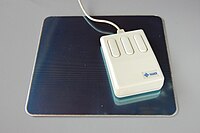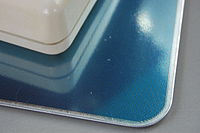This article has multiple issues. Please help improve it or discuss these issues on the talk page. (Learn how and when to remove these messages)
|
| [REDACTED] | |
| Formerly | Rodent Associates |
|---|---|
| Company type | Private |
| Industry | Computer peripherals |
| Founded | 1982; 43 years ago (1982) in Fremont, California |
| Founder | Steve Kirsch |
| Defunct | 1990 (1990) |
| Fate | Acquired by KYE Systems |
| Products | Computer mice |
Mouse Systems Corporation (MSC), formerly Rodent Associates, was founded in 1982 by Steve Kirsch. The company was responsible for bringing the mouse to the IBM PC for the first time.
History
Mouse Systems' optical mouse, wired to a Sun workstation and an Atari 400 running Missile Command, attracted many observers at the October, 1982 Mini/Micro '82 conference in Anaheim, California, attended by over 10000 people—and won a "best new product" award.
In 1984, MSC acquired rights to Mouse Draw from Microtex Industries, written by Doug Wolfgram. Mouse Systems wanted the software re-developed to look more like Apple's MacPaint so Wolfgram brought in co-developer John Bridges and together they re-wrote the program in C with an updated user interface and called it PCPaint. Millions of copies were shipped, primarily bundled with all their mice until 1987.
KYE Systems, producer of the Genius brand of mice, acquired Mouse Systems in 1990.
Technical details
 Mouse from a Sun workstation manufactured by Mouse Systems on its mousepad
Mouse from a Sun workstation manufactured by Mouse Systems on its mousepad Grid detail of mousepad
Grid detail of mousepad
Like all early optical mice, their debut product relied on a special metallic and reflective mousepad printed with a square grid of grey and blue tracking lines: as the device moved over the pad, light emitted by an LED was reflected by the pad onto an array of sensors whose output was processed by an on-board controller, which in turn supplied the host computer with machine-readable tracking data via an RS-232 serial port. When connected to a regular RS-232 port, an external power supply was required. Some mice would derive their power supply from the keyboard connector on the motherboard and came with a pass-through connector to be inserted before the keyboard cable.
Early Sun workstations used MSC optical mice exclusively. The mouse was connected via a dedicated connector with power, obviating the need for a separate power supply for the mouse. Initial models came with large mousepads with well-spaced lines, while later models were smaller and used a much tighter grid.
See also
References
- Markoff, John Gregory (1982-05-10). "Computer mice are scurrying out of R&D labs". InfoWorld. Vol. 4, no. 18. Berkeley, CA, USA: Popular Computing, Inc. pp. 10–11. ISSN 0199-6649. Retrieved 2015-08-26.
- Markoff, John Gregory (1982-05-17). "Rodent Associates make computer mice". InfoWorld. Vol. 4, no. 19. Sunnyvale, CA, USA: Popular Computing, Inc. p. 12. ISSN 0199-6649. Retrieved 2015-08-26.
- Mace, Scott (1982-10-11). "Speech tech, mice draw crowds at Mini/Micro 82". InfoWorld. Vol. 4, no. 40. Anaheim, CA, USA: Popular Computing, Inc. pp. 1, 6–7. ISSN 0199-6649. Retrieved 2020-02-07.
Further reading
- Paul, Matthias R. (2002-04-06). "Re: [fd-dev] ANNOUNCE: CuteMouse 2.0 alpha 1". freedos-dev. Archived from the original on 2020-02-07. Retrieved 2020-02-07.
The original Mouse Systems Bus Mouse is a normal serial 8250 compatible mouse using the normal Mouse Systems serial protocol, however the base address of this 8250 type chip is not one of the usual COM port addresses 3F8h, 2F8h, 3E8h, or 2E8h, but either 238h or 338h. Besides others these addresses are also supported as alternative addresses for serial ports on the German c't UniRAM add-on ISA card. Bus mice from other vendors use completely different interfaces, partially residing at the same I/O addresses
External links
- "Milestones". KYE Systems. Archived from the original on 2006-05-16. Retrieved 2006-05-16.
1990 Acquired Mouse Systems Corp. (MSC)
This article about a technological corporation or company is a stub. You can help Misplaced Pages by expanding it. |